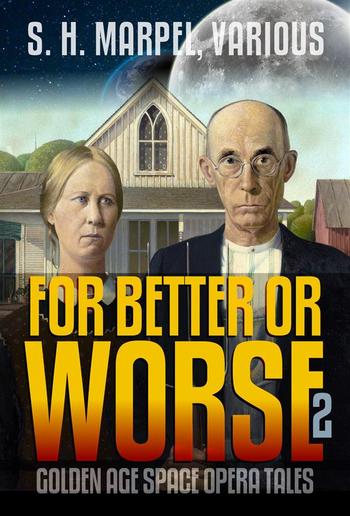
S. H. Marpel - For Better or Worse: Golden Age Space Opera Tales Volume 02
For Better or Worse: Golden Age Space Opera Tales Volume 02
S. H. Marpel, Various
Mô tả
Marriage is a popular theme in space. At least in space opera. That's why this anthology is the second of two on this subject.
Of course, our media would have you believe these days that all marriages are doomed to fail. However the space opera authors here are not so interested in what is as what could be. So the travails of the married and their potentials are far more interesting. And entertaining.
So set yourself down for these short stories and novellas which transport you to new worlds, all in the search for domestic bliss.
Space Opera is a subgenre of science fiction that emphasizes space warfare, melodramatic adventure, interplanetary battles, chivalric romance, and risk-taking. Set mainly or entirely in outer space, it usually involves conflict between opponents possessing advanced abilities, futuristic weapons, and other sophisticated technology.
The term has no relation to music, as in a traditional opera, but is instead a play on the terms "soap opera", a melodramatic television series, and "horse opera", which was coined during the 1930s to indicate a formulaic Western movie. Space operas emerged in the 1930s and continue to be produced in literature, film, comics, television, and video games.
The Golden Age of Pulp Magazine Fiction derives from pulp magazines (often referred to as "the pulps") as they were inexpensive fiction magazines that were published from 1896 to the late 1950s. The term pulp derives from the cheap wood pulp paper on which the magazines were printed. In contrast, magazines printed on higher-quality paper were called "glossies" or "slicks".
The pulps gave rise to the term pulp fiction. Pulps were the successors to the penny dreadfuls, dime novels, and short-fiction magazines of the 19th century. Although many writers wrote for pulps, the magazines were proving grounds for those authors like Robert Heinlein, Louis LaMour, "Max Brand", Ray Bradbury, Philip K. Dick, and many others. The best writers moved onto longer fiction required by paperback publishers. Many of these authors have never been out of print, even long after their passing.
Anthology containing:
Up for Renewal by Lucius Daniel
The Luminous Blonde by Hayden Howard
Garrity's Annuities by David Mason
Bimmie Says by Sydney J. Van Scyoc
The Addicts by Joseph Samachson
Jaywalker by Ross Rocklynne
Prime Difference by Alan Edward Nourse
Made to Measure by William Campbell Gault
Butterfly 9 by Donald Keith
Star-Crossed Lover by William W. Stuart
Man in a Sewing Machine by Jr. L. J. Stecher
Captives of the Thieve-Star by James H. Schmitz
Conditionally Human by Walter M. Miller
The Man Who Was Six by F. L. Wallace
Scroll Up and Get Your Copy Now.

